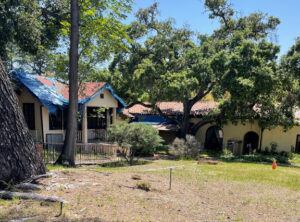
Photo by Mary O’KEEFE
It’s Women’s History Month and attention is once again turned to Rockhaven Sanitarium.
By Mary O’KEEFE
First Rockhaven Sanitarium’s history:
In 1920, U.S. Congress ratified the 19th Amendment to the U.S. Constitution that granted women the right to vote. The names Lucretia Mott, Elizabeth Cady Stanton and Susan B. Anthony are well known suffragettes whose work brought this issue to a successful conclusion in Congress. While this was going on, however, many women worked behind the scenes to fight for women’s rights.
During this time, before and after the right to vote was ratified, Agnes Richards was witness to some of the inequalities that were directed toward women –especially those women who did not have support, either emotional or financial.
This was a time when men were allowed to commit women to a hospital for a variety of reasons, including mental health issues like depression, but they could also be committed for symptoms of menopause; some were committed just because the men in their lives wanted to be free of them.
“In the worst-case scenario, a father or husband could have an adult woman undergo a surgery called a lobotomy, which resulted in severe personality changes as sections of the brain were severed from one another. Men could also sign to have women sterilized so they could not bear children. Lobotomy ceased to be an option in the western world in the [1980s] but forced sterilization has been recorded in California as late as 2010,” according to California Lutheran University’s article, “Rockhaven Sanitarium.”
This life is what was seen by Richards, who was a nurse. She knew she could offer an alternative to this barbaric approach to female mental health treatments. In 1923 she rented a cottage in the area that is now far north Glendale in the 2700 block of Honolulu Avenue. She renovated it and renamed it Rockhaven Sanitarium. She purchased that house, and then others, creating a place where women could come and feel safe. She started with six women and within three years had 25 “ladies” (she never used the term patient) living on the property.
She offered art and music therapy but more importantly gave women a place to regain their strength and their health. The sanitarium housed everyone from movie stars to housewives, but they were all treated with the same respect.
Richards ran Rockhaven until she died in 1967; it was then passed to her granddaughter Patricia Travis. Travis continued her grandmother’s legacy but in 2001 it was time for her to retire. She sold the sanitarium to a large hospital corporation, which closed the facility in 2006.
And this is where the story has a sad twist.
Community members saw the future of the Rockhaven property. It was in a prime area of far north Glendale. The community feared that this part of women’s history would disappear if something were not done. They reached out to the City of Glendale and together they worked to create a proposal that would keep Rockhaven open to the public as a park and library. The initial idea was to move Montrose Library to the Rockhaven location and allow Glendale Fire Station 29 to extend into the current library’s property, adding much needed space for the station.
The Glendale City Council approved the purchase of the 3.3-acre property in April 2008 for $8.25 million. The site included 15 buildings.
Then the downturn in the economy put everything on hold and changed the future of the institution.
Friends of Rockhaven, a grassroots non-profit born from the Historical Society of the Crescenta Valley, began its never-ending advocacy for Rockhaven.
For 16 years, Friends of Rockhaven has fought to bring the original plan for the sanitarium to fruition. Throughout the years City staff has offered several options for the property, including building apartment complexes and a hotel, but each time the plans fell through.
Friends of Rockhaven was successful in getting Rockhaven listed on the national and California state historical registries thinking this would protect the facilities; however, that does not seem to be the case.
Rockhaven Sanitarium has suffered from maintenance neglect, which many see as demolition by neglect although the City does not see it that way. For example, during recent rains Friends of Rockhaven had concerns about the rooftops and what the rain would do to the exterior and the interior of the buildings. Friends of Rockhaven contacted the City many times to get tarps put on the roofs, which it did. The problem is the tarps easily blew off or tore leaving the roofs and the buildings vulnerable to the weather and its elements.
In 2023, after several requests to support the buildings’ maintenance, Friends of Rockhaven filed a lawsuit against the City of Glendale.
“We formed as a non-profit to advocate on behalf of the community and the community is tired of the City deferring proper maintenance,” said Friends of Rockhaven president Joanna Linkchorst in a previous interview. “We felt this was a move we needed to take to make sure that this historic place will be saved to tell the story of Rockhaven and women in the mental health system.”
According to the lawsuit, the City of Glendale and its city council failed to “comply with the Glendale Municipal Code and prevent waste of taxpayer funds and injury to the public property by failing to maintain and preserve historic property originally known as Rockhaven Sanitarium.”
Next week, we will have Rockhaven Part II and report on what was discussed about the future of Rockhaven at a Feb. 27, 2024 city meeting.
